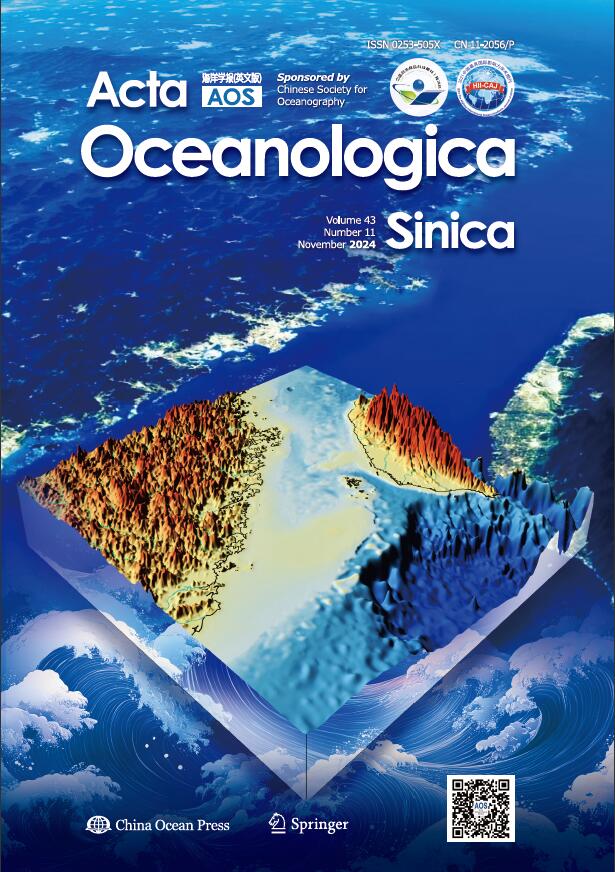2014 Vol. 33, No. 4
Display Method:
2014, 33(4): .
Abstract:
2014, 33(4): 1-12.
doi: 10.1007/s13131-014-0400-2
Abstract:
Okinawa Trough is a back-arc, initial marginal sea basin, located behind the Ryukyu Arc-Trench System. The formation and evolution of the Okinawa Trough is intimately related to the subduction process of the Philippine Sea Plate beneath the Eurasian ...
Okinawa Trough is a back-arc, initial marginal sea basin, located behind the Ryukyu Arc-Trench System. The formation and evolution of the Okinawa Trough is intimately related to the subduction process of the Philippine Sea Plate beneath the Eurasian ...
2014, 33(4): 13-21.
doi: 10.1007/s13131-014-0453-2
Abstract:
Based on the survey of surface sediment in Xiamen Bay in October 2011, the speciation, distribution, and potential ecological risk assessment of heavy metals (Cu, Pb, Zn, Cd, and Cr) in this area were studied using the sequential extraction method an...
Based on the survey of surface sediment in Xiamen Bay in October 2011, the speciation, distribution, and potential ecological risk assessment of heavy metals (Cu, Pb, Zn, Cd, and Cr) in this area were studied using the sequential extraction method an...
2014, 33(4): 22-29.
doi: 10.1007/s13131-014-0451-4
Abstract:
Dissolved organic matter (DOM) from freshwater, mid-salinity, and seawater endmember samples in the Jiulong River Estuary, China were fractionated using cross-flow ultrafiltration with a 10-kDa membrane. The colloidal organic matter (COM; 10 kDa-0.22...
Dissolved organic matter (DOM) from freshwater, mid-salinity, and seawater endmember samples in the Jiulong River Estuary, China were fractionated using cross-flow ultrafiltration with a 10-kDa membrane. The colloidal organic matter (COM; 10 kDa-0.22...
2014, 33(4): 30-36.
doi: 10.1007/s13131-014-0462-1
Abstract:
Distributions of the parameters of sedimentary grain sizes and their correlations were studied to trace the sources of silts and their movement trends in the Zhujiang River Estuary based on the analyses of grain sizes from more than 1 080 sedimentary...
Distributions of the parameters of sedimentary grain sizes and their correlations were studied to trace the sources of silts and their movement trends in the Zhujiang River Estuary based on the analyses of grain sizes from more than 1 080 sedimentary...
2014, 33(4): 37-44.
doi: 10.1007/s13131-014-0405-x
Abstract:
Investigations of the diffusion activities both within and outside the seafloor hydrothermal vents, as well as related mineral genesis, have been one of the key focuses of ocean biogeochemistry studies. Many hydrothermal vents are distributed close t...
Investigations of the diffusion activities both within and outside the seafloor hydrothermal vents, as well as related mineral genesis, have been one of the key focuses of ocean biogeochemistry studies. Many hydrothermal vents are distributed close t...
2014, 33(4): 45-54.
doi: 10.1007/s13131-014-0452-3
Abstract:
Two predominant currents, the warm Kuroshio Current and the cold Oyashio Current, meet in the Northwest Pacific Ocean. The dynamics of physical oceanographic structures in this region, including frontal zones and meandering eddies, result in a highly...
Two predominant currents, the warm Kuroshio Current and the cold Oyashio Current, meet in the Northwest Pacific Ocean. The dynamics of physical oceanographic structures in this region, including frontal zones and meandering eddies, result in a highly...
2014, 33(4): 55-76.
doi: 10.1007/s13131-014-0415-8
Abstract:
Identification of hydrozoan species is challenging, even for taxonomic experts, due to the scarcity of distinct morphological characters and phenotypic plasticity. DNA barcoding provides an efficient method for species identification, however, the ch...
Identification of hydrozoan species is challenging, even for taxonomic experts, due to the scarcity of distinct morphological characters and phenotypic plasticity. DNA barcoding provides an efficient method for species identification, however, the ch...
2014, 33(4): 77-84.
doi: 10.1007/s13131-014-0450-5
Abstract:
On the basis of morphological observations, life history and molecular phylogeny, Grateloupia yangjiangensis, which is similar to G. filicina, G. orientalis, G. catenata, and G. ramosissima in appearance, was re-examined. The results are as follows: ...
On the basis of morphological observations, life history and molecular phylogeny, Grateloupia yangjiangensis, which is similar to G. filicina, G. orientalis, G. catenata, and G. ramosissima in appearance, was re-examined. The results are as follows: ...
2014, 33(4): 85-91.
doi: 10.1007/s13131-014-0413-x
Abstract:
Phosphorus (P) is one of the key nutrients for the growth of phytoplankton. In this study, we used a method coupling label-free quantitation with liquid chromatography-mass spectrometry (LFQ-LC-MS/MS) to track the change of relative protein abundance...
Phosphorus (P) is one of the key nutrients for the growth of phytoplankton. In this study, we used a method coupling label-free quantitation with liquid chromatography-mass spectrometry (LFQ-LC-MS/MS) to track the change of relative protein abundance...
2014, 33(4): 92-100.
doi: 10.1007/s13131-014-0455-0
Abstract:
Fructose-1,6-bisphosphatase (FBPase) is one of the key enzymes in Calvin circle and starch biosynthesis. In this study, the full-length of cpFBPase gene from Pyropia haitanensis was cloned by using rapid amplification of cDNA ends (RACE) technology. ...
Fructose-1,6-bisphosphatase (FBPase) is one of the key enzymes in Calvin circle and starch biosynthesis. In this study, the full-length of cpFBPase gene from Pyropia haitanensis was cloned by using rapid amplification of cDNA ends (RACE) technology. ...
2014, 33(4): 101-107.
doi: 10.1007/s13131-014-0456-z
Abstract:
Heavy metals in the surface sediments and sediment core from the Xiangshan Bay, a mariculture base on the coast of the East China Sea, were determined by inductively coupled plasma mass spectrometry (ICP-MS) in order to evaluate their levels and sour...
Heavy metals in the surface sediments and sediment core from the Xiangshan Bay, a mariculture base on the coast of the East China Sea, were determined by inductively coupled plasma mass spectrometry (ICP-MS) in order to evaluate their levels and sour...
2014, 33(4): 108-111.
doi: 10.1007/s13131-014-0449-y
Abstract:
Abundances of the fireworm Hermodice carunculata were counted through a monitoring assessment study of fish cages in Barranco Hondo (NE Tenerife). Seven campaigns were conducted from November 2007 to June 2010 and temporal variations were found, as w...
Abundances of the fireworm Hermodice carunculata were counted through a monitoring assessment study of fish cages in Barranco Hondo (NE Tenerife). Seven campaigns were conducted from November 2007 to June 2010 and temporal variations were found, as w...














